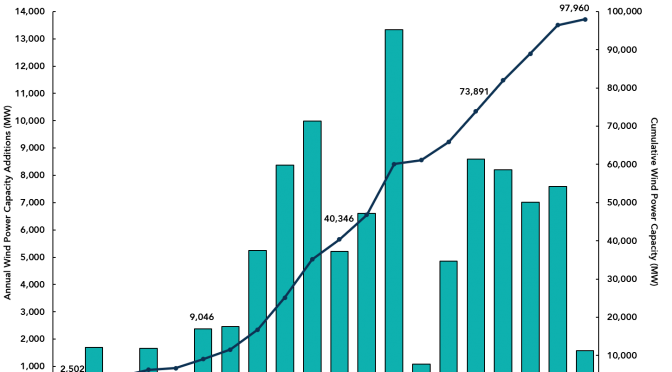Everyone likes a nice, round number, and American wind power is approaching a big one: 100 gigawatts (GW) of installed capacity. AWEA’s just-released U.S. Wind Industry Second Quarter Market Report shows record-breaking, continued growth for the U.S. wind industry.

The country added 736 megawatts (MW) of wind capacity to the grid as developers commissioned four new wind farms in the second quarter. That brings installations for the year to 1,577 MW, a 53 percent increase over the first half of 2018. There are now 97,960 MW of wind power operating in the U.S., bringing the industry within shouting distance of the 100 GW milestone, enormous progress considering there were only 2.5 GW in operation at the start of the century.

Wind development pipeline hits new heights
The total U.S. wind development pipeline hit a new high of nearly 42 gigawatts (GW) in the second quarter, as developers started construction or found purchasers for 7,290 MW of wind power in the last three months. The near-term wind project pipeline includes a record 20,908 MW under construction, with an additional 20,892 MW in advanced development. Over 200 wind projects are now underway across 33 states. In 15 of those states over 1,000 MW of wind capacity will come online in the next few years.
Powering up with wind
Corporate and utility customers’ demand for low-cost, reliable wind energy to power their operations continued to grow in the second quarter. Businesses and utilities announced 1,962 MW of new power purchase agreements (PPAs) in the quarter, contributing to a total of 4,799 MW for the year. Second quarter PPAs were evenly split, with corporate customers accounting for 52 percent of PPA capacity (1,013 MW), and utilities signing the remaining 48 percent (949 MW). Hormel Foods, Smithfield Foods, Crown Holdings, and Ernst & Young signed up to buy wind energy for the first time, while Target, Walmart, and General Mills added more wind to their portfolios.
A new ocean energy resource
The second quarter also saw exciting developments for the offshore wind industry along the East Coast. Three states passed legislation creating new offshore wind targets, including Maryland (1,200 MW), Connecticut (2,000 MW), and New York (9,000 MW). New Jersey selected the largest offshore wind project in the country to date – Ørsted’s 1,100 MW Ocean Wind project – as the winner of its first large-scale solicitation. With the addition of this project, there are over 3,000 MW of offshore wind in advanced development. Other highlights include Massachusetts issuing its second request for up to 800 MW of offshore wind, and Connecticut issuing a draft request for up to 2,000 MW of offshore capacity.
Better technology= more power
Wind turbine technology also continues to evolve. Wind turbine manufacturers have introduced new models at a rapid pace over the past few years in pursuit of lower costs and enhanced performance. As a result, the number of projects selecting turbines with a capacity of 3.5 MW or more is growing significantly. Fourteen percent of turbines installed year-to-date are rated between 3.4 MW to 3.6 MW. Looking forward, wind turbine manufacturers publicly reported 2,049 MW of orders in the second quarter for turbines ranging in capacity from 4.2 to 4.5 MW. These turbines are capable of powering twice the number of homes as the average wind turbine installed over the past few years.
All of these developments and more (which can be found in the full Second Quarter Market Report) show the contributions the wind industry is making across the country. Wind technician and manufacturing jobs will continue their contributions to local economies as the pipeline (both onshore and offshore) is transformed into online projects.
A public version of the second quarter market report is available for download here.




